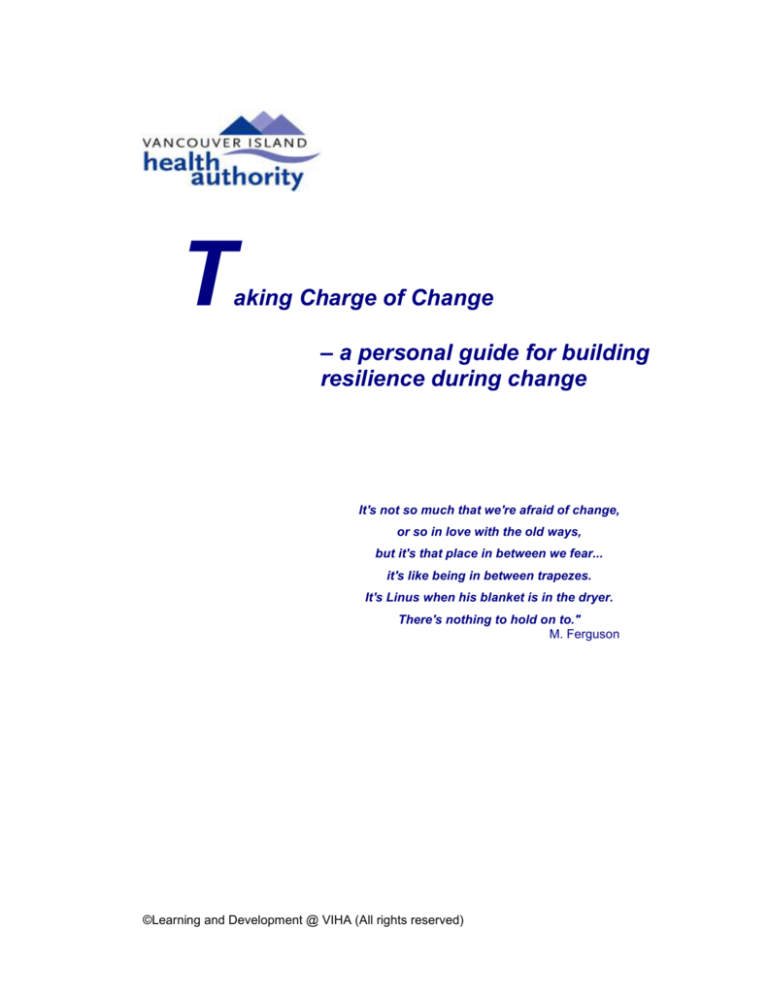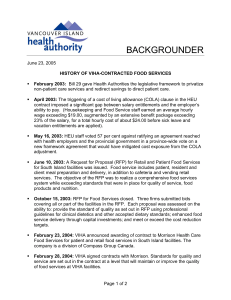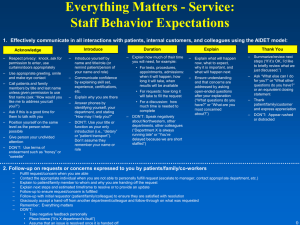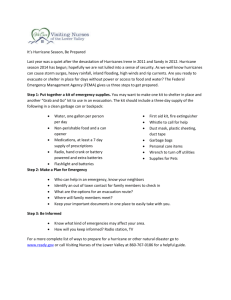
T
aking Charge of Change
– a personal guide for building
resilience during change
It's not so much that we're afraid of change,
or so in love with the old ways,
but it's that place in between we fear...
it's like being in between trapezes.
It's Linus when his blanket is in the dryer.
There's nothing to hold on to."
M. Ferguson
©Learning and Development @ VIHA (All rights reserved)
Change and Transition Tool Kit
Taking Charge of Change
Consider This…
“There has been more information produced in the last 30 years than during the
previous 5,000. A weekday edition of the New York Times contains more
information than the average person was likely to come across in a lifetime in
17th century England. The information supply available to us doubles every five
years.”
- Richard Saul Wurman, Information Anxiety
“Computer power is now 8,000 times less expensive than it was 30 years ago…if
we had similar progress in automotive technology, today you could buy a Lexus
for about $2. It would travel at the speed of sound and go about 600 miles on a
thimble of gas.
- John Naisbitt, Global Paradox.
“Today’s average consumers wear more computing power on their wrists than
existed in the entire world before 1961.”
- Ian Morrison and Greg Schmid,
- Future Tense: The Business Realities of the Next Ten Years.
“These are the good old days.
- Unknown
©Centre for Excellence in Learning @ VIHA (All rights reserved)
Used with permission
Page 1
Change and Transition Tool Kit
Taking Charge of Change
Purpose Of This Guide
The purpose of this guide is to provide University of Victoria employees with
some tips to help build and maintain resilience and flexibility during change, so
that you can take care of yourself and your well being during these difficult times.
Why Is Taking Charge Of Change So Challenging?
In these times of uncertainty, as announcements are made or not made, and our
lives are affected or about to be affected by restructuring and budget issues, it is
normal to feel shocked, resentful, anxious, and stressed – at least for a period of
time. The truth is these times are frustrating for all of us – leaders and staff
members alike. It’s frustrating partly because, the information we need to make
decisions is not readily available; indeed many decisions that may affect us are
yet to be made, and the time frames for making them are not firm.
And, along with the announcements comes a cloud of uncertainty… the future is
ambiguous… information is not always available… the ‘truth’ seems to be a
moving target… and rumours abound.
Many of us will find ourselves becoming self-absorbed and withdrawn as we
worry about what will happen to us in the change ahead. This is a normal and
natural response to uncertainty. The reality is that dramatic change is
uncomfortable, and many of us won’t like what is happening. But most of us will
want to figure out how to make the adjustments necessary to succeed in the new
environment, whatever that may be.
The good news is…
There is something we can do to help ourselves survive and even thrive during
these difficult times.
©Centre for Excellence in Learning @ VIHA (All rights reserved)
Used with permission
Page 2
Change and Transition Tool Kit
Taking Charge of Change
So Let’s Get Started…
It is important to understand the difference between change and transition.
Change is the change in the external situation; the thing that has changes – it
happens quickly. Transition is the reorientation people need to make in response
to the change. This can take time.
Our past experience with change can get in the way of how we deal with our
current changes. We are all uniquely different in how our history affects us, our
reactions to change and to the meaning that we ascribe to a change as we go
through it.
Does This Sound Familiar?
To understand the difference between change and transition think of what
happens when you move house. The change is the actual move. It involves
packing your belongings, loading the truck, and driving across town to your new
house. The transition involves all the confusion, distress, and excitement that
you and your family go through as you change addresses. It involves the time
when you aren’t sure who your neighbours are, where the nearest corner store is
and all the work you do to make your new house your own. The period of
transition nears an end when you realize that your house has become a home
and that you are comfortable and settled.
©Centre for Excellence in Learning @ VIHA (All rights reserved)
Used with permission
Page 3
Change and Transition Tool Kit
Taking Charge of Change
Something To Think About…
If you think about how many changes you have been through in your life, you will
see that you have already experienced many change and transition cycles. Like
the examples given earlier, some changes are exciting and self-motivated.
Others, like organizational change, are often imposed upon us. But change is all
around us and happening all the time. Anytime something old ends or something
new begins, our world is impacted. It changes a little or a lot. Below are some of
the areas where change happens in our life, and more often than not, they
overlap.
WORK
WORK
SOCIAL
FAMILY
OTHER
To clarify the change and transitions in your own life, use the chart on the next
page to ‘map’ the changes you are dealing with. You might want to include those
you have dealt with in the past 2 years, and those you think you might need to
deal with in the next couple of years. The changes may be at different stages.
You may have just entered into one change process in your work life and be in
the midst or at the end of another one in your family situation. The point is to
identify as many as possible.
©Centre for Excellence in Learning @ VIHA (All rights reserved)
Used with permission
Page 4
Change and Transition Tool Kit
Taking Charge of Change
PAST
(18-24 months)
NOW UNDERWAY
©Centre for Excellence in Learning @ VIHA (All rights reserved)
Used with permission
FUTURE
(18-24 months)
Page 5
Change and Transition Tool Kit
Taking Charge of Change
Understanding Our Response to Change
Although we each respond to change in our own unique way, we all seem to go
through the same phases of transition.
Transition is not a process that moves in an orderly way from step to step. We
move through these stages at different speeds and sometimes we can get ‘stuck
along the way’. The emotional impact and the stress of dealing with change are
inevitable, whether we see the change as positive or negative, chosen or not.
You can use the Change and Transition Model below to help you:
Understand your own response to the change
Figure out ‘where you are at’ for a specific change
Find ways to address your needs during change
Use the model to ‘map out’ where you think you currently are for a specific change
The change you are dealing with
©Centre for Excellence in Learning @ VIHA (All rights reserved)
Used with permission
Page 6
Change and Transition Tool Kit
Taking Charge of Change
The Lull Between The Waves
In between major changes you might enjoy a time when you are not involved in
any major transition. This time is included in the Transition Model because we
believe that the ‘lull between the waves’ provides an opportunity to get ready for
the next change. Preparing can help you move through transition more easily.
Here are some things you can be doing to prepare for change and transition.
Some ideas to think about:
Watch for signs of upcoming changes that may affect you
Find out all you can about personal transition
Develop skills that will help you better deal with change and
transition
The charts on the pages that follow describe the phases of transition and provide
some suggestions for moving through each phase. Remember that people go
through the stages of transition at different speeds and intensities. We are all
different, and there is no right or wrong way to feel about, or work through, a
change.
©Centre for Excellence in Learning @ VIHA (All rights reserved)
Used with permission
Page 7
Change and Transition Tool Kit
Taking Charge of Change
Dealing With Denial
Possible Reactions
Feelings:
Shock, agitation, apathy, numbness,
disbelief
Behaviours:
Withdrawal, activity without getting
much done
Thinking/Saying:
"This is no big deal.”
“I don't know what everyone is upset
about."
"They've said this before and nothing
happened."
"I'll believe it when I see it."
"It doesn't affect me."
"This won't really change anything."
"What announcement? Oh that. I
didn't really pay much attention."
Focus:
Immediate
Suggested Actions
Listen, for and seek the
information you need to deal
with the changes
Ask questions to find out what
is changing and what is not
(e.g. ask your leaders, send
questions to the newsletter)
Decide how this change might
you, your work group and
other groups with which you
interact.
Knowledge and Skills:
Taking Charge of Change
Grieving process
Communication skills
©Centre for Excellence in Learning @ VIHA (All rights reserved)
Used with permission
Page 8
Change and Transition Tool Kit
Taking Charge of Change
Your Action Plan
1.
Am I comfortable to stay in denial right now?
2.
If not, what can I do to make this situation easier for myself?
3.
What do I need to ask for from my team? How can I ask for this?
4.
What do I need from my manager? How can I influence this happening?
5.
What do I need from senior leaders? How can I influence this happening?
©Centre for Excellence in Learning @ VIHA (All rights reserved)
Used with permission
Page 9
Change and Transition Tool Kit
Taking Charge of Change
Dealing With Resistance And Making A Good Ending
Possible Reactions
Feelings:
Guilt, resentment, anxiety, selfabsorption, stress, depression, anger,
fear, defiance
Behaviours:
Asking questions, challenging,
complaining, failing to see any positive
outcomes, can't sleep, withdraw, hide,
sabotage, blame, “retirement on the
job”
Thinking/Saying:
"Why are they doing this to us?”
"This is crazy. Who's idea was this
anyway?"
"Why can't things stay the way they
are?"
"This will never work."
"They don't know anything about “_”.
How can they decide this?"
"What's going to happen to me?"
Focus:
On the past, on what was, and on
concern for the unknown future
Suggested Actions
Continue to ask questions to get the
information you need and find out
how the change affects you.
Express your concerns.
Assess and mourn your losses.
(What is over and what is not?)
Mark what is ending for you or your
work group (event, ceremony,
memento, piece of the past,
commemorations, and celebrations
for past successes).
Seek support, talk to others about
their losses and reactions.
Look at your past losses or
changes. Are they getting in the
way?
Stay in tune with your feelings and
reactions… Talk to a friend… Keep
a journal… Seek counselling and
support from EFAP.
Take care of yourself and your well
being.
Skills and Knowledge:
Dealing with Change
Grieving and loss
Communication
Listening
©Centre for Excellence in Learning @ VIHA (All rights reserved)
Used with permission
Page 10
Change and Transition Tool Kit
Taking Charge of Change
Your Action Plan
1.
Am I feeling OK with my ‘resistance’ right now?
2.
What is ending for me with this change? What steps can I take to make a good
‘good-bye’? What could my team/work group do to make a good ‘good-bye’?
3.
What is not ending or what might I be able to maintain or re-gain even though other
things are changing?
4.
What else will I do to make this situation easier for myself?
5.
What do I need to ask for from my team? How can I ask for this?
6.
What do I need from my manager? How can I influence this happening?
7.
What do I need from senior leaders? How can I influence this happening?
©Centre for Excellence in Learning @ VIHA (All rights reserved)
Used with permission
Page 11
Change and Transition Tool Kit
Taking Charge of Change
Exploring And Hanging Out In The Neutral Zone
Possible Reactions
Feelings:
Some hope and optimism, some
frustration, can't focus, confusion
Behaviours:
Adjustment, bargaining, willing to get
involved, too much to do, many new
ideas, over-preparation, chaos
Thinking/Saying:
"Things are a mess. We are so
disorganized."
"How did we decide to do this? I
forget.”
"I am so tired. I don't know which end
is up."
"I am waking up in the middle of the
night, and my head is spinning with all
the kinds of ideas.”
"Sometimes I know where I am going,
and sometimes I just feel lost."
"It is scary to think we could do just
about anything. No one knows what
anyone else is doing."
Focus:
On the future
Suggested Actions
Gain a greater sense of control
by: getting involved, gaining
access to decision makers,
setting goals, and minimizing
personal changes.
Seek a greater understanding by
finding out decisions being made
and the information you need.
Develop your support systems
by: confiding in someone, letting
others know what you need.
Re-establish your sense of
purpose and direction by taking
stock of your skills, talents,
abilities and achievements,
clarifying what success means to
you.
Develop a training plan to get the
skills and knowledge you need.
Brainstorm new ideas,
experiment with new ways of
doing things.
Participate in activities to
develop your team.
Skills and Knowledge:
Career Planning
Creativity and Innovation
Team skills
©Centre for Excellence in Learning @ VIHA (All rights reserved)
Used with permission
Page 12
Change and Transition Tool Kit
Taking Charge of Change
Your Action Plan
1.
Am I OK ‘exploring’ and comfortable in the ‘neutral zone’ right
now?
2.
Do I need a greater sense of control? If so, what will I do to gain a sense of
control?
3.
Do I need more understanding of what is happening? If so, what will I do to find out
more?
4.
What do I need to ask for from my team? My family? My friends? And others to
gain support during this time? Who and how will I ask for support?
5.
What will I do to take stock of my life so far including my achievements? Who can
help me develop a personal training plan?
6.
What do I need from my manager? How can I influence this happening?
7.
What do I need from senior leaders? How can I influence this happening?
©Centre for Excellence in Learning @ VIHA (All rights reserved)
Used with permission
Page 13
Change and Transition Tool Kit
Taking Charge of Change
Gaining Commitment And Making A New Beginning
Possible Reactions
Feelings:
Acceptance, commitment, hope,
satisfaction
Behaviours:
Rebuilding, cooperation, clear focus and
planning
Thinking/Saying:
"How can we work on this?”
"Oh I get it. I see what you mean, I didn't
understand what you were trying to tell
me."
"When you get used to this it isn't half
bad."
Focus:
On the future
Suggested Actions
Set personal career objectives
and develop a career plan.
Put together a plan to develop
the skills and knowledge you
need.
Continue to work with the
team/work group to rebuild.
Find some low risk setting to
practice new skills, for a few
quick successes.
Find a mentor to coach you.
Celebrate your successes.
Skills and Knowledge
Career and Resume
Teamwork
Planning and Objective Setting
©Centre for Excellence in Learning @ VIHA (All rights reserved)
Used with permission
Page 14
Change and Transition Tool Kit
Taking Charge of Change
Your Action Plan
1.
What can I do to make this situation easier for myself?
2.
What are my personal objectives for my career?
3.
What is my plan for developing the skills and knowledge I need? How will I practice
these new skills?
4.
What do I need from my team mates and peers? How will I ask for this?
5.
What do I think we can do as a team? How will go about this?
6.
What do I need from my manager? How can I influence this happening?
7.
What do I need from senior leaders? How can I influence this happening?
©Centre for Excellence in Learning @ VIHA (All rights reserved)
Used with permission
Page 15
Change and Transition Tool Kit
Taking Charge of Change
Getting Ready For The Next Wave
Possible Reactions
Suggested Actions
Thinking/Saying:
"It's funny how upsetting it all was. It
feels like ancient history now."
"I can't say I love this new job but it's
OK."
"It took me a while to get used to the
people on the team but now it feels
like we have always worked together."
"I suppose they will change this too
someday, but for now it feels pretty
effective."
Needs to:
Reflect on the change experience
and personal transition process to
identify insights.
Develop a strategy for taking
charge of the next wave of
change.
What can you do to get ready for the next wave of change?
©Centre for Excellence in Learning @ VIHA (All rights reserved)
Used with permission
Page 16
Change and Transition Tool Kit
Taking Charge of Change
In Summary
Phase
Individual
The Lull Between
The Waves
Look for signs and develop skills for change and
transition
Denial
Listen, seek, and ask
Resistance
Ask, express, mourn, and seek support
(Endings)
Exploration
(Neutral Zone)
Seek control, understanding, support, purpose,
plan and participate.
Commitment
Develop knowledge and skills
(New Beginning)
Celebrate success
Getting Ready For
The Next Wave
Reflect on experience and develop strategies
©Centre for Excellence in Learning @ VIHA (All rights reserved)
Used with permission
Page 17
Change and Transition Tool Kit
Taking Charge of Change
Some Things to Remember:
Those involved in planning the change start their transition first and
reach their beginnings first. Do you want to get involved?
People experience transition in differing intensity and move through the
stages at different speeds depending on factors such as:
The degree to which the change takes them by surprise
The degree the change places them in an uncertain or unfamiliar
situation
Their role in the change
Their clarity about the expected outcomes of the change
Their stage of life
The number of other transitions they are experiencing at the same
time
Their opportunity to express vulnerability or uncertainty
Their individual temperament (e.g. MBTI preference)
Their personal self awareness
Whether or not there is a specified end time for the change
The impact upon them personally
The availability of current, relevant information
People will differ in terms of how difficult their endings and how they
experience their losses
©Centre for Excellence in Learning @ VIHA (All rights reserved)
Used with permission
Page 18
Change and Transition Tool Kit
Taking Charge of Change
References and Resources
References
Ackerman, L., (1982). Transition Management: An In-depth Look at Managing
Complex Change. Organizational Dynamics, 42-66
Bridges, William. (1991). Managing Transition: Making the Most of Change.
Addison-Wesley
Conner, Daryl. (1993). Managing at the Speed of Change, New York, Villard.
O’Neil, Mary Beth, (2000) Executive Coaching: with Backbone and Heart, San
Francisco, Jossey-Bass Publishers
Scott, C.D. & Jaffe, D.T. (1991). From Crisis to Culture Change. Health Care
Forum Journal. May/June p.33-41.
Additional Books
Bridges, William. (1994). Job Shift. Addison-Wesley
Bridges, William. (1990). Surviving Corporate Transition. William Bridges &
Associates
Bridges, William. (1980). Transitions: Making Sense of Life’s Changes. AddisonWesley
Beckhard, R., Harris, R.T. (1987). Organizational Transitions - Managing Complex
Change. Addison-Wesley
Belasco, J.A. Teaching the Elephant to Dance - Empowering Change in Your
Organization. Crown Publishers, Inc.
Childre, D., Cryer B., (2000) From Chaos to Coherence (the power to change
performance), Planetary, Heartmath
Hale S.J., Williams, M.M., Managing Change – A Guide to Producing Innovation from
Within, 1989, Urban Institute Press
Jaffe, T., Scott, C.D., Tobe, G.R. (1994). Rekindling Commitment. Jossey-Bass
©Centre for Excellence in Learning @ VIHA (All rights reserved)
Used with permission
Page 19
Change and Transition Tool Kit
Taking Charge of Change
Moss Kanter, R. (1983). The Change Masters. Simon & Schuster
Moss Kanter, R. (1989). When Giants Learn to Dance. Touchstone
Noer, David. Healing the Wounds. Barnes & Nobel
Senge, P.M. (1990). The Fifth Discipline. Doubleday Currency
Senge. P.M. (1999), The Dance of Change, Doubleday, Currency
Tannen, D. (1990). You Just Don’t Understand: Women and Men in Conversation.
Morrow, William & Company
Articles:
Adams, J.D. & Spencer, S.A. (1988). People in Transition. Training and Development
Journal. Oct. p.61-63.
Demers, R., Forrer, S.E., Leibowitz, Z., Cahill, C. (1996). Commitment to Change.
Training and Development Journal. Aug. p.22-26.
Galpin, T. (1996). Connecting Culture to Organizational Change. Human Resource
Management. Mar. p.84-90.
Scott, C.D. & Jaffe, D.T. (1993). Stress & Stress Management in the Workplace. In
M.P. O’Donnell, J.S. Harris (eds), Health Promotion in the Workplace. Delmar
Scott, C.D. & Jaffe, D.T. (1991). From Crisis to Culture Change. Health Care Forum
Journal. May/June p.33-41.
Pamphlets:
Bridges, William. (1987). Dealing Successfully with Personal Transition. AddisonWesley
Bridges, William. (1987). Getting Them Through the Wilderness. Addison-Wesley
Bridges, William. (1987). Surviving the Survivor Syndrome. William Bridges &
Associates
Bridges, William. (1991). Managing Non-Stop Change. William Bridges & Associates
©Centre for Excellence in Learning @ VIHA (All rights reserved)
Used with permission
Page 20
Change and Transition Tool Kit
Taking Charge of Change
Pritchett, Price & Pound, Ron. A Survival Guide to the Stress of Organizational
Change.
Pritchett, Price. (1987), The Employee Survival Guide to Mergers & Acquisitions.
Pritchett, Price & Pound, Ron. (1990). The Employee Handbook for Organizational
Change.
Pritchett, Price & Pound, Ron. (1992). Building a High Performance Work Group During
Change.
Pritchett, Price. (1996). Resistance, Moving Beyond the Barriers to Change.
The above pamphlets can be borrowed from Organization Development and Learning
Videos:
The Art of Communication and the Science of Change with Cynthia Scott
The New Workplace: Changing Relationships Between Employees & Employers
Survival Skills for the Future with Jennifer James, Ph.D.
Windows of Change with Jennifer James, Ph.D.
The Power of Vision, Discovering the Future Series. Joel Arthur Barker
The Business of Paradigms, Discovering the Future Series. Joel Arthur Barker
©Centre for Excellence in Learning @ VIHA (All rights reserved)
Used with permission
Page 21










